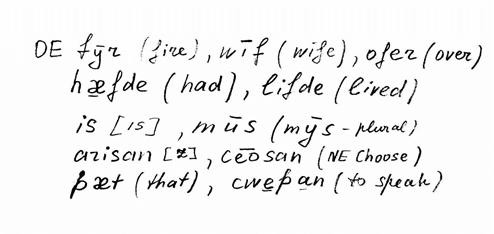The Anglo-Saxon script and peculiarities of the Old English alphabet
The earliest records of English that have come down to us are dated in the 7th century. The period preceding this date is called pre-written. The Old English written monuments represent two types of script – the so called runic alphabet and Latin alphabet. The Runic alphabet was adopted by Anglo-Saxons on the continent before coming to the Island. It is a special type of script used by all Germanic tribes before they became Christians. They adopted Christianity in the 7th century. In the year England was Christianized.
The conversion resulted in supplanting the Runic alphabet by the Latin one. But so far as the Old English phonetic system differed greatly from that of Latin, the Latin alphabet appeared somewhat defective to convey the Anglo-Saxon sounds. The Old English scribes (писцы) filled this want by borrowing several symbols from the Runic alphabet. Besides, some ligatures used in Latin were adopted and finally some letters of the Latin alphabet were used to designate two or more different sounds.
1. The Latin ligatures: ae [æ], oe [œ] [ö] indicated the front vowels æ and ö;
OE sæde (said), spræc (spoke), gœs (goose)
2. An open [o], intermediate between o and a, was indicated by the letters a and o, the scientific publications of OE texts transcribing it as a, o, å – in OE the last vowel occurred only before nasals: OE mån(n), lånd, strång;
3. The symbol y [ü] was used to designate a labialized vowel (front rounded) similar to German ü – OE fyllan (to fill), OE mys (mice) < musi, OE fyr (fire).
4. OE diphthongs were spellt with two letters, the pronunciation coinciding with the spelling of the diphthong, except ea pronounced as æa
OE deop (deep), OE hie (they), OE ieldra (older) but OE eal [æal] (all), OE heard [hæard] (hard).

The Latin letter ʒ (the so-caled insular ʒ )was used to indicate 4 different consonant sounds:
1) the palatal (front) stop [g’];
2) the velar (back) stop [g];
3) the palatal fricative [j];
4) the velar fricative [γ].
The difference between these 4 sounds is reflected in modern English as they developed into difference sounds:
Palatal stop [g’] is reflected in modern English as an affricate [dʒ ]:
OE brycʒ [g’], OE ecʒ [g’] > [dʒ] (Mod.E. bridge, edge).
Velar stop [g] is reflected in modern English as the same sound [g]:
OE sinʒan > Mod. E. sing, OE lånʒ > MnE long, OE strånʒ > ME strong.
Palatal fricative has been preserved in MnE in the beginning of the word and has been vocalized in final position forming together with the preceding vowel a diphthong (e.g. day, may):
OE ʒeolu > MnE yellow, OE ʒeard > MnE yard, OE ʒear > MnE year
OE dæʒ > MnE day, OE wæʒ > MnE way.
Velar fricative [γ] is reflected in Modern English as [w] indicating the second element of the diphthong [ou]:
OE boʒa > MnE bow [bou], OE borʒian > MnE borrow, OE folʒian > MnE follow, OE fuʒol > MnE fowl.
5. Four letters of the Old English alphabet, three from Latin – f, s, and one from Runic alphabet (the letter thorn) had a twofold (двойное) pronunciation indicating the corresponding voiced and voiceless fricatives:
f – [f] and [v];
s – [s] and [z],
ð межзуб. – [ð] and [Θ]
þ ( the runic letter thorn) – [Θ] and [ð]
The voiced variation was pronounced when the letter occurred between two voiced sounds (between two vowels or between a vowel and a voiced consonant). In all other positions (at the beginning, at the end of a word and in voiceless environment) these letters symbolized voiceless fricatives.

6. The Latin letter c indicated in OE only stop consonants – the palatal [k’] and the velar [k]. When followed by a front vowel or in final position this letter was pronounced as palatal [k’] – cild, benc, ceosan. In all other positions it was pronounced as [k] cuman (to come), сån (can).
7. The Latin latter halso had a two-fold pronunciation indicating the voiceless aspirate [h] in the beginning of a word and the back-lingual (gutteral) fricative [х] (как русское Х) at the end of a word and before a consonant:
hē, hie (they), hū (how), hūs (house) – [h];
neah, riht (right), meaht (might)–[х].
In the last case in Modern English spelling we have the combination gh which has become mute.
8. To conclude the peculiarities of OE script the following is to be added. In OE short and long vowels were distinguished, the quantity of speech sounds being of phonemic value, i.e. the length of a vowel had some meaning. However, in OE manuscripts the quantity of vowels was not marked in any way. In publications of the manuscripts long vowels are always distinguished from short ones by being marked with the macron, e.g. ā (a straight line above the vowel), short vowels being usually unmarked.
OE sæde (said), ceosan (to choose) with long vowels but
Þæt (that), heard (heard), hunta (hunt) with short vowels.
In OE side by side with long vowels there existed long consonants which were substantially double consonants and were spellt with two letters, but were pronounced as one. OE sittan (to sit), habban(to have). At the end of a word double consonant might be indicated either with one letter or with two letters:
OE spell/spel, OE mann/man, OE full/ful adj (full).
If a double consonant was followed by a third consonant, the former was simplified and reduced to one:
OE fyllan (to fill) – fylde – (past tense) filled
OE habban (to have) – hæfde (had), OE libban (to live) – lifde (livede).